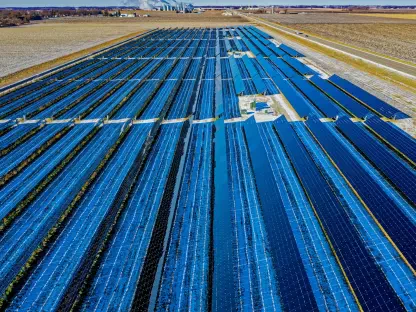What if the power to stabilize an entire state’s energy grid lay not in massive power plants, but in the humble batteries tucked away in thousands of homes across California? This innovative concept is no longer a distant dream but a tangible reality taking shape through a groundbreaking virtual power plant (VPP) initiative. With electricity demand soaring and climate challenges intensifying, this taxpayer-funded program promises to reshape how energy is managed during critical peak times, potentially saving millions in costs. The idea of aggregating home storage systems into a unified grid resource is capturing attention for its bold approach to reliability and affordability.
The significance of this development cannot be overstated. California, a leader in renewable energy adoption, faces persistent grid stress, especially during heatwaves and evening demand spikes. A recent analysis projects that this VPP program, specifically the Demand Side Grid Support (DSGS) initiative, could yield net system cost savings of up to $206 million by 2028. Managed by the California Energy Commission, DSGS incentivizes residents to contribute power from their behind-the-meter battery systems, creating a decentralized yet powerful solution. This story explores how such an ambitious effort could redefine energy security while navigating funding hurdles and scalability concerns.
A Bold Vision for California’s Energy Grid
Could California’s future hinge on a virtual network of residential batteries rather than traditional power infrastructure? This question drives the conversation around the state’s pioneering VPP model. By linking distributed energy resources like home battery storage into a cohesive system, the initiative acts as an invisible power plant, dispatching energy precisely when the grid needs it most. The potential is staggering, with projections estimating savings between $28 million and $206 million over the next few years, offering a glimpse into a more sustainable and cost-effective energy landscape.
This program isn’t just about numbers; it’s about transforming how energy crises are tackled. During periods of high demand, such as sweltering summer evenings, the grid often relies on expensive and polluting gas peaker plants. The DSGS framework challenges this status quo by tapping into existing residential resources, reducing both costs and environmental impact. As California pushes toward cleaner energy goals, this virtual approach could serve as a cornerstone for balancing innovation with urgent grid needs.
Why Virtual Power Plants Are Critical Now
California’s energy challenges are mounting, with rising electricity consumption and extreme weather events straining the grid. The need for reliable, affordable power has never been more pressing, especially as the state transitions to a higher share of renewables, which can be intermittent. Virtual power plants offer a solution by aggregating small-scale storage systems into a unified resource, capable of responding swiftly to fluctuations in supply and demand.
At the heart of this effort is the DSGS program, overseen by the California Energy Commission since its inception. This initiative compensates participants for allowing their home batteries to discharge power during grid stress events, effectively turning households into mini power stations. Such a strategy not only eases pressure on infrastructure but also aligns with broader trends in distributed energy, where consumers play an active role in stabilizing the system.
The implications extend beyond technical fixes to everyday life. For policymakers, this represents a scalable model to meet ambitious climate targets without sacrificing reliability. For residents, it means potential savings on bills and a direct stake in the state’s energy future. As renewable adoption grows, virtual power plants stand out as a bridge between individual action and collective impact.
Unpacking DSGS: Economic Wins and Real-World Impact
Delving into the specifics, the economic promise of the DSGS program is striking. Expert analysis forecasts net system cost savings ranging from $28 million to a high of $206 million by 2028, driven by reduced dependence on costly peak power sources. These savings could translate into lower electricity rates for consumers, a critical relief amid rising energy expenses.
Operationally, the program has already proven its worth. In a recent test event during a high-demand evening window, over 100,000 participants discharged a combined 539 megawatts of power from their batteries, rivaling the output of traditional facilities. Managed by major players in the energy storage space, this demonstration highlighted the reliability and responsiveness of a virtual network, showcasing its capacity to step in when the grid is most vulnerable.
Looking ahead, the growth trajectory is equally compelling, with battery capacity under DSGS expected to double to over 1 gigawatt within a few years. Yet challenges loom, notably an $18 million budget cut that threatens expansion. This funding shortfall raises questions about how quickly the program can scale to displace dirtier energy sources like gas plants, underscoring the tension between immediate fiscal constraints and long-term benefits.
Industry Leaders and Advocates Speak Out
Insights from key figures in the energy sector illuminate the transformative potential of this virtual model. Sunrun CEO Mary Powell has emphasized that aggregating home storage creates a “flexible, scalable resource” unmatched by conventional systems. Similarly, Tesla Energy’s senior director Colby Hastings noted the unique ability of such programs to deliver power precisely when and where it’s needed, enhancing grid stability.
Analysts have also weighed in with actionable recommendations. A comprehensive report highlights the importance of flexible event triggers and deeper integration into state energy planning to maximize impact. These suggestions point to a need for adaptive strategies that evolve with grid demands, ensuring the program remains effective as participation grows.
On the policy front, advocacy groups like the California Energy Storage Alliance are sounding the alarm over funding cuts, urging lawmakers to commit at least $75 million for 2026. Their push for multi-year financial support reflects a broader concern that without stable backing, the program’s momentum could falter. This mix of optimism and urgency from stakeholders paints a nuanced picture of both opportunity and obstacle.
Building a Stronger Virtual Power Plant Framework
To fully realize the potential of DSGS, strategic enhancements are essential. One key step involves refining dispatch methods to enable additional grid services, such as frequency regulation, beyond just peak demand response. Optimizing how and when power is released from batteries could amplify the program’s value, making it a more versatile tool for energy management.
Equally critical is the role of policymakers in securing long-term funding. Stable financial commitments would not only sustain current efforts but also attract private investment, fostering innovation and broader adoption. Establishing a predictable budget framework could position California as a global leader in virtual power plant technology, setting a precedent for other regions.
Consumer engagement remains a vital piece of the puzzle. Residents can contribute by enrolling their behind-the-meter battery systems in DSGS, earning incentives while bolstering statewide reliability. Clear communication about benefits, from personal savings to environmental impact, could drive participation, turning individual actions into a collective force for grid resilience.
Reflecting on this journey, California’s venture into virtual power plants marked a pivotal moment in energy innovation. The DSGS program demonstrated that distributed resources could rival traditional infrastructure in both scale and reliability. Yet, funding struggles reminded stakeholders of the delicate balance between ambition and practicality. Moving forward, prioritizing sustained investment and refining operational strategies emerged as crucial steps to ensure this model thrived. Encouraging wider consumer involvement also stood out as a way to solidify the foundation, proving that a united effort could power a more sustainable tomorrow.









